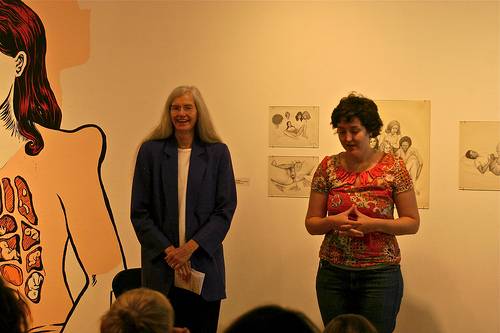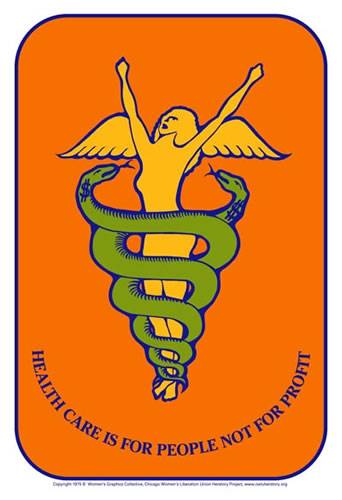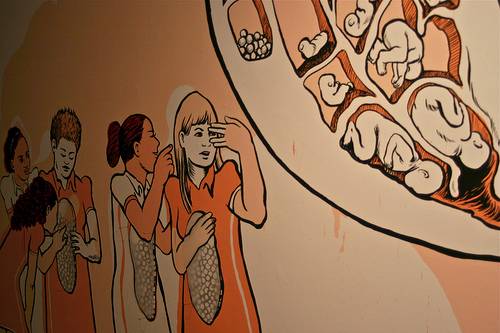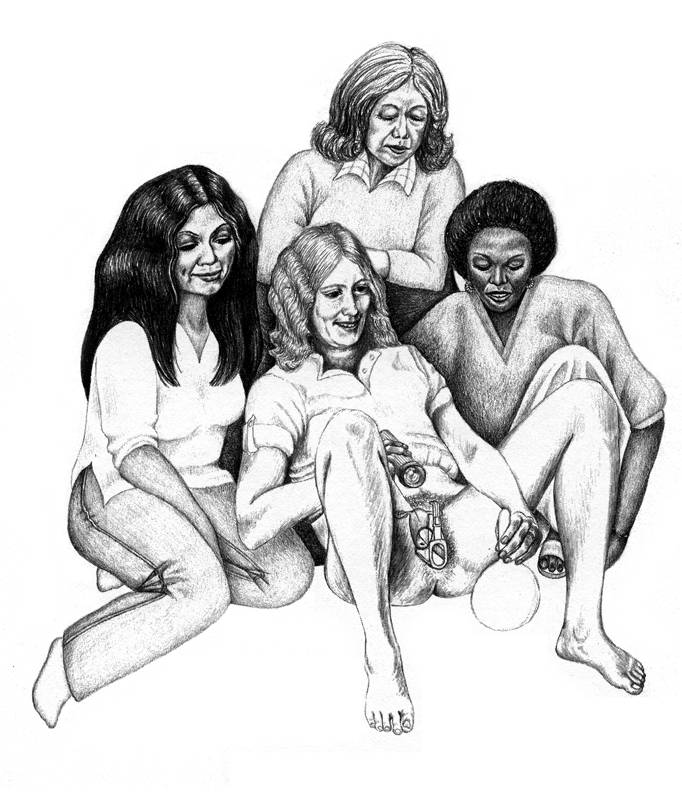
Not only is Bonnie Fortune (above on the right) a third year MFA student and educator in Art and Design, but she is also the curator for the newest exhibit, EveryBody!: Visual Resistance in Feminist Health Movements, 1969-2009, at I space — the University of Illinois’ art gallery in Chicago. EveryBody!, according to Fortune, is an exhibition dealing with radical visual culture surrounding feminist health movements past and present. It combines video, web, mural, poster, performance, illustration, and even wallpaper media into an exploration of a place where health care is a human right and all bodies are celebrated.
Smile Poiltely got a chance to catch Bonnie right after her opening for a quick interview about life in Champaign-Urbana and about her role in the unabashed art exhibit based around the feminist health movement.
Age: 30
Location: Pre-historic East Urbana
Consumed by: Right now? Trying to relax after a lot of work and manage my last year of graduate school!
When shopping at Common Ground Food Co-op, I always buy Coconut Macaroons + Lavender Soda.
You also teach a course (Intro to Time-Based Media Arts). What have you learned from your students?: To go slowly and explain carefully, I tend to get excited about an idea or a concept, and get ahead of myself.
What about Champaign-Urbana makes you smile?: The amazing “backyard” culture, from folks that work/run businesses at home, to backyard chickens, to people talking to each other over the fence or even building a gate in the fence to make it easier for neighbors to pass through, to sharing extremely local food with one another. C-U backyard culture is sustaining.
For those who aren’t familiar with the role of a curator, can you explain what you did for the show?: A curator writes a lot. She writes about the concept of the show-history, context, and artwork. She writes to the artists to determine their willingness and ability to participate, and what sort requirements they have to be able to participate, like materials needs, shipping needs, etc. She also writes grants to obtain funding, and writes to donors to obtain funding. She writes to the press to make sure they know about the show. After its all over she writes thank you notes to everyone that made it possible to put on an exhibition, and it takes a lot of people. Artists, for sure, but also preparators, printers, wine-deliverers, package-deliverers, gallery directors, press people, those ladies at Copymax making copies, a lot of people.
Besides writing, a curator meets with people and talks to them about ideas and possibilities, does studio visits with artists to talk about ideas and possibilities, and introduces artists to each other and to the press so that everyone will start talking to each other about ideas and possibilities.
For EveryBody! I wanted the show to reflect the incredible creativity coming out of feminist health activism and the work being done to re-imagine bodies, health care services, and what is considered normal. So, I tried to seek out images and projects that were made by artists, but also specifically activist projects, and combine them with historical work to express an interdisciplinary and vibrant approach to this subject. So, you get projects like Women on Waves from the Netherlands next to Christa Donner’s wall drawing, “Inheritance” which imagines a sex-education class in the future. Or work that combines medical illustration and research with a more poetic approach to illustration, like the work of Faith Wilding and Suzann Gage.
My hope for EveryBody! is for visitors to be immersed in a celebratory space, and to really consider all the different options available for learning about and exploring a subject. I want the ideas and visual culture of feminist health movements to be celebrated and discussed, but I also want visitors to leave with an expanded notion of what can be considered art, and how art can overlap with activism.
What one piece of artwork included in the show strikes a chord with you? Why?: I am psyched by all the work, really and this question is difficult to respond to. I am inspired by the honesty in the online journal by Madsen Minax that presents a heartfelt take on breast removal surgery and transitioning. I love Christa Donner’s wall mural “Inheritance” (see image above) for her particular drawing style and the idiosyncratic way she combines biological fact with fiction to imagine a completely different approach to sexuality and reproductive health. And I have to mention the collaborative webblog, started by Anjali Taneja and others in Los Angeles. It is a group blog that provides a space for other voices and stories in the health care debate to be heard.
 When do you find time for your own art? When you do — what medium do you use?: Well, I actually have a piece in the show, its an interview project that I did with activist, artist, and nurse practitioner Suzann Gage (artwork by Suzann on the right). I collaborated with the group Temporary Services to add the interview to their ongoing series highlighting radical artists, activists, and musicians — Temporary Conversations. I like to interview people and places, and this comes out as either a booklet, like the one above, or as video, or sound work. Basically, I like to create spaces for people and places to tell their stories.
When do you find time for your own art? When you do — what medium do you use?: Well, I actually have a piece in the show, its an interview project that I did with activist, artist, and nurse practitioner Suzann Gage (artwork by Suzann on the right). I collaborated with the group Temporary Services to add the interview to their ongoing series highlighting radical artists, activists, and musicians — Temporary Conversations. I like to interview people and places, and this comes out as either a booklet, like the one above, or as video, or sound work. Basically, I like to create spaces for people and places to tell their stories.
Our health care system needs a lot of things, but I would say certainly, insurance industry reform and a universal access to health care plan. Then I would say acknowledgment of provider (nurses, doctors, etc.) labor in such away that encourages thoughtful patient care and healthy provider patient relationships, not the current system that rewards more services not more care.
Make your way up to I space Gallery before the show ends on October 10. I space is located at 230 W. Superior St., on the 2nd floor, in Chicago.








